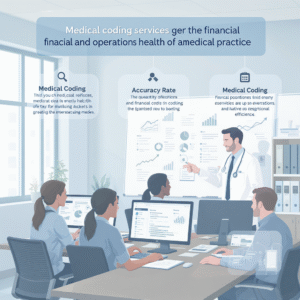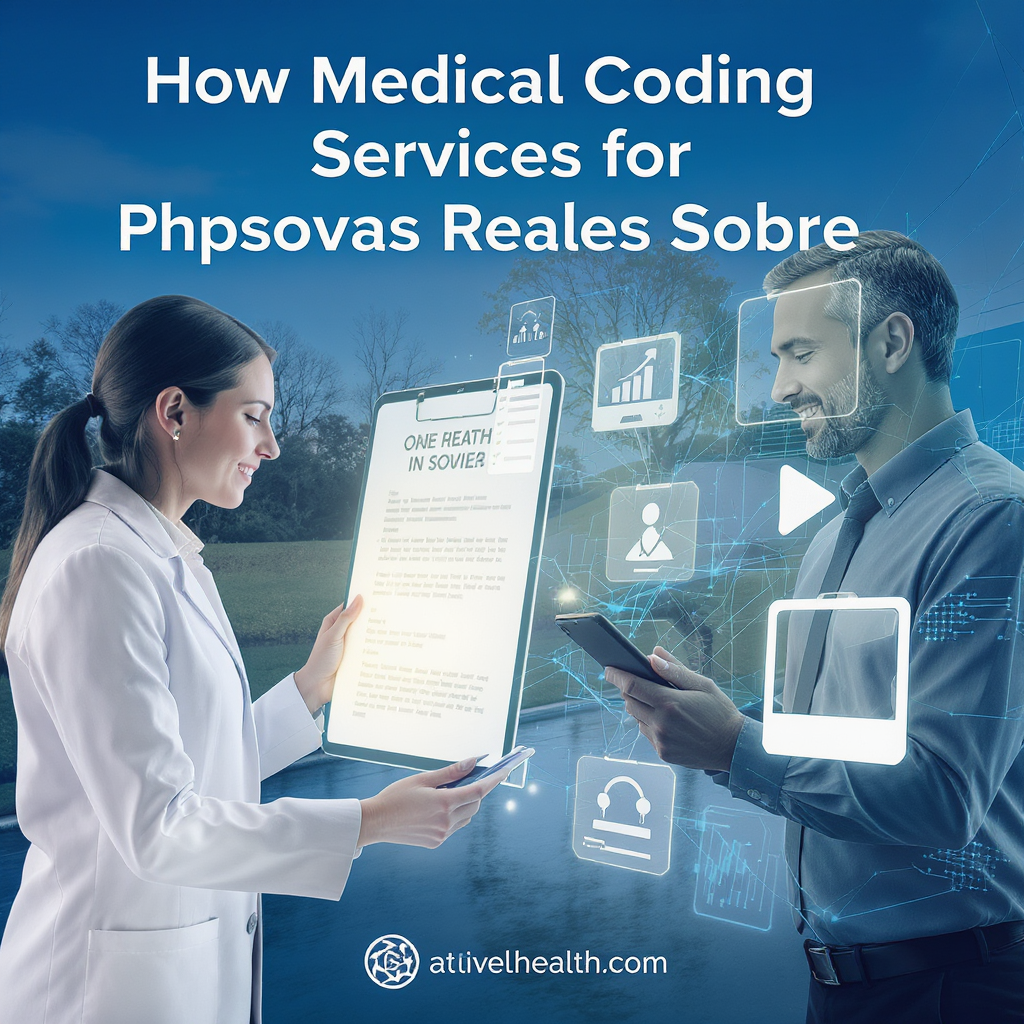A Universal Language for Health: How Medical Coding Services for Physicians Improve Practice Health
Medical Coding Services
Medical Coding Services
In the complex and ever-evolving world of healthcare, the health of a practice is not measured solely by the quality of care provided to patients. Behind every diagnosis, treatment, and procedure lies an intricate administrative system that is the true heart of the practice: medical coding. This standardized language, invisible to most patients, is the engine that drives the revenue cycle, regulatory compliance, and operational efficiency. Without accurate and efficient medical coding, even the most successful practice can face significant financial and administrative challenges.

For physicians, medical coding can seem like an arduous and confusing task. Constant code changes, regulatory complexity, and the pressure to maintain a healthy cash flow leave many feeling overwhelmed. This is where medical coding services come in. Outsourcing this vital function to experts is not only a strategy to ease the administrative burden, but a crucial investment in the long-term health and sustainability of a medical practice. In this blog, we’ll explore in detail how medical coding services for physicians can become an indispensable partner in improving the health of the practice as a whole.
The Basics: What is medical coding and why is it so crucial?
Before diving into the benefits of coding services, it’s critical to understand what medical coding is and why it’s so important. Essentially, medical coding is the process of translating a patient’s diagnoses, procedures, medical equipment, and services into a set of standardized alphanumeric codes. These codes are the common language that allows information to flow seamlessly between physicians, hospitals, insurers, and regulatory agencies.
The most well-known coding systems are the International Classification of Diseases (ICD-10) for diagnoses and Current Procedural Terminology (CPT) for procedures. Each code represents a specific concept, from a simple visit to a common cold to complex heart surgery. Accurate application of these codes is key to the integrity of health records and billing. An incorrect code can lead to a claim denial, a delay in payment, or even an audit by the insurance company.
The complex ecosystem of modern coding
The world of medical coding has evolved dramatically in recent years. The transition from ICD-9 to ICD-10, for example, multiplied the number of available codes from approximately 14,000 to more than 70,000. This expansion was not merely numerical; it represented a shift toward greater specificity and detail in medical documentation. While ICD-9 could have a general code for “arm fracture,” ICD-10 requires specifying the exact location, type of fracture, whether it is initial or follow-up, and many other details.
Additionally, there are other coding systems, such as the Healthcare Common Procedure Coding System (HCPCS) for durable medical equipment and supplies, and the Diagnosis-Related Groups (DRG) for hospitals. Each of these systems has its own rules, annual updates, and specific documentation requirements.
Medical coding not only affects billing. It also has a direct impact on:
- Medical research and public health: Coded data enables the collection of large-scale statistics, helping to identify patterns and trends in population health and plan public health initiatives.
- Patient safety: Standardizing codes reduces the risk of medical errors by eliminating ambiguities in communication between healthcare professionals.
- Resource management: Provides a clear view of patient workload and needs, facilitating better planning and organization of services.
- Data-driven decision-making: Accurate codes enable detailed analysis of practice performance, identification of growth opportunities, and optimization of the most profitable services.
The challenge of internal coding: Why it’s not always the best option
For many medical practices, coding is done in-house, often by office staff who also handle other administrative tasks. While this may seem like a cost-saving option, it presents several significant challenges:
1. Lack of specialization and continuous training
Office staff may not have the formal training necessary for coding. The world of medical coding is constantly changing, with new revisions and updates to guidelines being published regularly. Staying up-to-date requires a commitment of time and resources that most practices cannot afford.
Continuing education in medical coding is expensive and time-consuming. Professional coders must earn certifications such as CPC (Certified Professional Coder) or CCS (Certified Coding Specialist), which require years of study and practical experience. Maintaining these certifications requires annual continuing education and recertification exams.
2. Workload and risk of errors
Administrative staff are already busy with appointment scheduling, patient care, and other responsibilities. Adding the complex task of coding increases the risk of errors due to haste or lack of concentration. A simple typo or the selection of an incorrect diagnosis code can have a domino effect on the revenue cycle.
Studies show that practices that handle coding internally have significantly higher error rates, especially when staff are overworked. These errors not only affect revenue but can also create long-term compliance issues.
3. Impact on the revenue cycle
Coding errors are one of the leading causes of claim denials by insurers. A denied claim means a delay in payment, which directly impacts the practice’s cash flow. The time and effort required to appeal and correct these claims adds up, creating a bottleneck that negatively impacts the practice’s financial health.
According to industry data, the average cost of processing a denied claim can be up to five times higher than that of processing a clean claim from the start. This cost includes not only staff time but also follow-up resources, communications with insurers, and the potential for the complete loss of the claim.
4. Regulatory compliance risk
Regulations like the Health Insurance Portability and Accountability Act (HIPAA) and other compliance requirements are strict and complex. Coding errors can lead to legal and financial penalties, including audits that can be costly and damaging to the practice’s reputation.
Government audits, especially those related to Medicare and Medicaid, have increased significantly in recent years. Inaccurate coding can result in accusations of fraud, even when the errors are unintentional, which can lead to substantial fines and exclusion from federal healthcare programs.

The Strategic Solution: How Medical Coding Services for Physicians Become an Invaluable Asset
Outsourcing medical coding is more than just delegating tasks; it’s a strategic decision that strengthens your practice from the ground up. Medical coding services for physicians offer several key benefits that directly address the challenges of in-house coding:
1. Dramatically improved accuracy and reduced errors
Professional coding services employ certified and experienced coders who specialize in the task. These experts not only know the codes but also understand medical language and documentation guidelines. Their unique approach is to ensure that each diagnosis, procedure, and service is coded with the utmost specificity and accuracy.
- Familiarity with clinical documentation: A skilled coder can extract the necessary information from the physician’s notes, even if the documentation is imperfect, reducing the need for constant interactions for clarification.
- Knowledge of regulatory changes: Coding services are responsible for keeping up with the latest updates to codes and compliance guidelines. This removes the burden from the practice and ensures that the correct codes are always used.
- Reduced Denials: Accurate coding on the first attempt significantly reduces the number of claim denials, resulting in more stable and predictable cash flow.
2. Revenue cycle optimization and increased profitability
The revenue cycle is the sequence of events that runs from the patient’s appointment to the receipt of final payment. Inaccurate coding or an inefficient process can create bottlenecks and lost revenue. Medical coding services optimize this cycle in several ways:
- Increased processing speed: Professional coders work efficiently and dedicatedly, speeding up the coding and billing process. Faster claims processing means faster payments.
- Maximizing Reimbursement: A skilled coder not only assigns the correct codes but also ensures that all eligible services and procedures are billed. Coding services have the expertise to identify and bill these additional services.
- Analysis and Monitoring: Coding services provide detailed analysis of denial patterns, enabling the practice to identify and correct systemic issues.
3. Advanced technology and tools
Professional coding services use specialized software and artificial intelligence tools that can identify patterns, suggest codes based on clinical documentation, and detect potential errors before claims are submitted. This technology is beyond the reach of most small practices due to its cost and complexity.
Modern coding platforms include features such as real-time code verification, diagnosis and procedure compatibility analysis, and automatic alerts for insufficient documentation. These tools significantly increase the accuracy and efficiency of the coding process.
4. Freeing up valuable time and resources for patient care
One of the most significant advantages of outsourcing coding is the freeing up of practice staff. The office team can focus on what they do best: interacting with patients, managing scheduling, and creating an exceptional care experience.
- The physician can focus on medicine: With the peace of mind that coding is in the hands of experts, the physician can focus on consultation, diagnosis, and treatment.
- Improved staff morale: By reducing tedious tasks and the stress associated with billing errors, staff morale improves.
- Reduced administrative costs: In the long run, outsourcing coding can be more cost-effective than maintaining an in-house team.

5. Compliance assurance and risk reduction
The regulatory landscape in the healthcare sector is a maze of constantly changing rules. Professional coding services are designed to navigate this labyrinth, staying up-to-date with all federal, state, and private insurance regulations.
Key factors to consider when choosing an encoding service
Not all coding services are created equal. When evaluating options, medical practices should consider several critical factors:
Certifications and credentials
Coders must hold industry-recognized certifications, such as CPC, CCS, or CCA. They must also have specific expertise in the practice’s medical specialty, as each specialty has its own unique coding and documentation requirements.
Technology and data security
The service must use secure technology and be HIPAA-compliant. This includes data encryption, controlled access, and regular security audits. Integration with the practice’s electronic medical records (EMR) system is also crucial for efficiency.
Transparency and communication
A good coding service should provide regular performance reports, including metrics such as denial rates, processing time, and coding trends. They should also be available for questions and clarification.
Scalability
The service must be able to adapt to the growth of the practice, handling fluctuating volumes of work without compromising quality or delivery times.
An in-depth case study: Transforming a family practice
Let’s examine the case of Esperanza Family Clinic , a practice with three physicians and six administrative staff. For years, two assistants handled coding while also managing other administrative responsibilities. The problems piled up:
- Denial rate of 18% (industry standard is 5-7%)
- Average payment time of 45 days (target is 21-30 days)
- Estimated revenue loss of 12% annually due to suboptimal coding
After implementing a professional medical coding service:
Results in 6 months:
- The denial rate was reduced to 6%.
- The average payment time decreased to 28 days
- Net income increased by 15%
- Administrative staff reported significantly lower stress levels
- Patient satisfaction improved due to increased staff attention
Financial Results: The cost of the coding service represented approximately 3% of the practice’s revenue, but the increase in net income and reduction in administrative costs resulted in a 400% return on investment in the first year.
The Future of Medical Coding: Emerging Trends
Medical coding continues to evolve with technological advances and regulatory changes:
Artificial Intelligence and Machine Learning
AI systems are beginning to assist in automatic coding, using natural language processing to extract codes from clinical notes. However, expert human oversight remains essential to ensure accuracy.
Telemedicine and new codes
The pandemic accelerated the adoption of telemedicine, requiring new codes and modifiers. Professional coding services quickly adapted to these changes, while many practices struggled to keep up.
Value-based payment models
The shift toward value-based payment models requires even more precise coding to demonstrate the quality and outcomes of care. This makes professional coding expertise even more valuable.

Conclusion: An investment in the future of medical practice
In today’s healthcare ecosystem, medical coding is much more than a simple administrative task. It is the cornerstone of a practice’s financial health and sustainability. The decision to outsource coding services to experts is not an expense, but a smart investment that generates significant returns in the form of increased accuracy, revenue cycle optimization, risk reduction, and the invaluable opportunity to focus on what matters most: patient care.
Medical practices that adopt professional coding services not only improve their immediate financial health but also position themselves for long-term success in an increasingly complex and regulated healthcare environment. In a world where every code counts, where every error can cost thousands of dollars, and where regulatory compliance is non-negotiable, medical coding services have become an indispensable strategic partner.
For physicians looking to improve the efficiency, profitability, and overall health of their practices, medical coding services are the key to unlocking a more prosperous and less stressful future. It is the universal language that translates exceptional clinical work into a successful and healthy medical practice, allowing physicians to do what they do best: heal.



